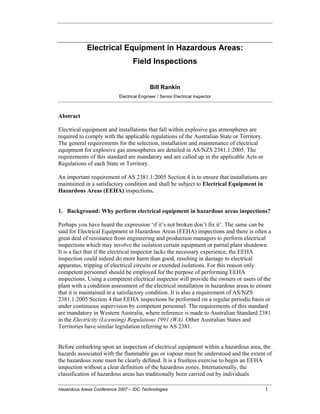The 8-Minute Rule for Roar Solutions
The 8-Minute Rule for Roar Solutions
Blog Article
7 Easy Facts About Roar Solutions Explained
Table of Contents5 Simple Techniques For Roar SolutionsThe Best Guide To Roar SolutionsRoar Solutions Fundamentals Explained
In such an atmosphere a fire or surge is possible when three standard problems are met. This is frequently described as the "dangerous area" or "combustion" triangular. In order to secure setups from a prospective surge a technique of evaluating and identifying a potentially harmful location is needed. The purpose of this is to ensure the right choice and installation of tools to ultimately stop an explosion and to ensure security of life.
(https://www.mixcloud.com/roarsolutions/)
No tools must be installed where the surface area temperature of the equipment is above the ignition temperature level of the given risk. Below are some typical dust harmful and their minimal ignition temperature level. Coal Dirt 380C 225C Polythene 420C (melts) Methyl Cellulose 420C 320C Starch 460C 435C Flour 490C 340C Sugar 490C 460C Grain Dust 510C 300C Phenolic Resin 530C > 450C Aluminium 590C > 450C PVC 700C > 450C Residue 810C 570C The probability of the risk being present in a concentration high adequate to create an ignition will certainly differ from area to area.
In order to identify this risk an installation is split into areas of threat relying on the quantity of time the harmful exists. These areas are referred to as Areas. For gases and vapours and dusts and fibers there are 3 zones. Zone 0 Zone 20 A hazardous ambience is extremely most likely to be present and may be present for extended periods of time (> 1000 hours annually) or also constantly Zone 1 Area 21 A hazardous ambience is feasible yet not likely to be existing for long durations of time (> 10 450 C [842 F] A classification of T6 implies the minimum ignition temperature level is > 85 C [185 F] Harmful area electrical devices maybe designed for use in higher ambient temperatures. This would certainly showed on the rating plate e.g. EExe II C T3 Ta + 60C( This means at 60C ambient T3 will not be surpassed) T1 T1, T2, T3, T4, T5, T6 T2 T2, T3, T4, T5, T6 T3 T3, T4, T5, T6 T4 T4, T5, T6 T5 T5, T6 T6 T6 A T Course rating of T1 suggests the optimum surface area temperature level created by the instrument at 40 C is 450 C. Thinking the associated T Class and Temperature level score for the tools are suitable for the area, you can constantly use an instrument with a much more strict Division score than required for the area. There isn't a clear response to this question. It actually does depend on the sort of equipment and what repair work require to be lugged out. Tools with certain test treatments that can not be done in the field in order to achieve/maintain 3rd party ranking. Need to come back to the manufacturing facility if it is prior to the devices's solution. Area Repair Work By Authorised Personnel: Challenging testing may not be called for nevertheless specific procedures may require to be followed in order for the devices to keep its third event score. Authorized employees should be used to carry out the job properly Repair need to be a like for like substitute. New element have to be taken into consideration as a straight replacement needing no unique screening of the equipment after the repair is full. Each piece of equipment with a hazardous ranking need to be reviewed separately. These are detailed at a high level below, yet for more detailed info, please refer straight to the standards.
Roar Solutions Can Be Fun For Everyone
The equipment register is a detailed data source of devices records that consists of a minimum collection of areas to identify each thing's place, technical parameters, Ex-spouse classification, age, and ecological data. The proportion of Detailed to Close assessments will certainly be determined by the Devices Risk, which is evaluated based on ignition risk (the likelihood of a source of ignition versus the probability of a flammable atmosphere )and the unsafe location category
( Zone 0, 1, or 2). Applying a robust Risk-Based Inspection( RBI )approach is important for making certain compliance and security in handling Electrical Devices in Hazardous Areas( EEHA).
What Does Roar Solutions Mean?

In terms of eruptive risk, a dangerous location is a setting in which an explosive ambience is present (or might be anticipated to be existing) in amounts that need unique safety measures for the building, installment and use of equipment. Roar Training Solutions. In this short article we check out the difficulties faced in the work environment, the risk control procedures, and the called for competencies to function safely
These compounds can, in certain problems, create explosive environments and these can have significant and terrible consequences. Most of us are familiar with the fire triangle get rid of any one of the 3 aspects and the fire can not happen, however what does this mean in the context of hazardous areas?
In the majority of instances, we can do little about the degrees of oxygen airborne, yet we can have considerable impact on resources of ignition, for instance electrical equipment. Dangerous locations are documented on the unsafe area classification drawing and are identified on-site by the check out this site triangular "EX LOVER" sign. Here, among various other crucial details, zones are divided right into 3 kinds depending upon the hazard, the possibility and duration that an eruptive atmosphere will certainly exist; Area 0 or 20 is deemed one of the most unsafe and Zone 2 or 22 is deemed the least.
Report this page